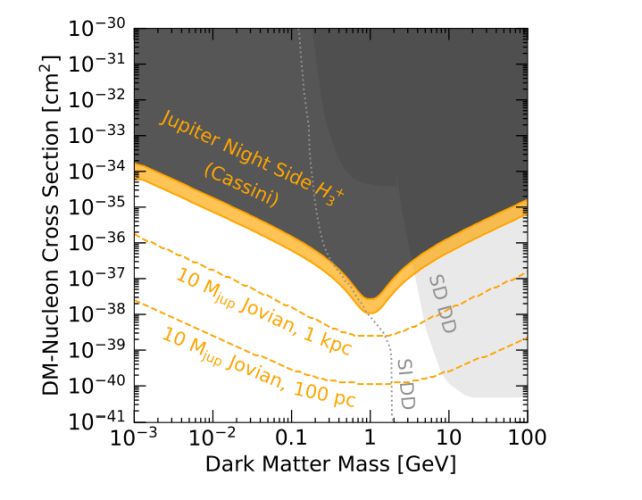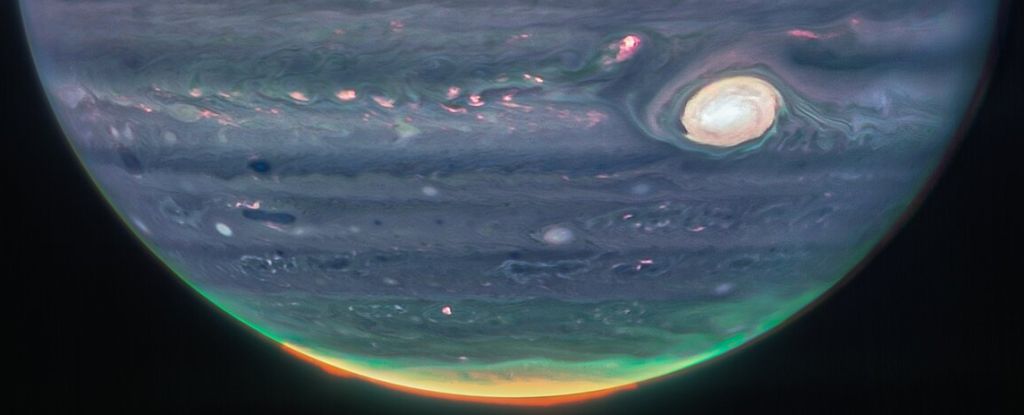Somewhere, out there, lurking in the Universe, is a whole bunch of matter we haven’t been able to find.
And it’s not a trivial amount, either. Roughly 70 to 80 percent of all mass is considered to be the mysterious stuff known as dark matter. Normal matter makes up the minority. That’s everything we can detect – all the stars, planets, black holes, dust, gas, moons, people.
So where is all this dark matter? Well, we don’t know. But there are ways we may be able to detect it, and one of them is right here in the Solar System.
On the night side of Jupiter, an infrared glow high up in the atmosphere could be produced by an interaction with this shadowy material.
There, charged hydrogen ions called trihydrogen cations (H3+) can be found in abundance. And, while there are several cosmic processes that can produce H3+ in the Jovian atmosphere, an interaction with dark matter could produce an excess beyond what we’d expect to find.
“We point out that dark matter can produce an additional source of H3+ in planetary atmospheres,” write physicists Carlos Blanco of Princeton University and Stockholm University, and Rebecca Leane of the Stanford Linear Accelerator Center (SLAC) National Accelerator Laboratory and Stanford University.
“This will be produced if dark matter scatters and is captured by planets, and consequently annihilates, producing ionizing radiation.”
Although we can’t detect dark matter directly, and although it doesn’t seem to interact with normal matter in ways we can detect indirectly, there is one way it manifests. Objects in the Universe seem to be moving as though under the influence of way more gravity than is being produced by normal matter.
Once we subtract the normal matter contribution, the gravity left over is attributed to dark matter. This is how we know something is there and can measure how much of it there is.
There are many different theoretical candidates for what dark matter could be, and many of these candidates have properties that could be detected in various ways.
One idea is that dark matter is self-annihilating. When two dark matter particles collide, they wipe each other out, producing a little burst of heat or light or both.
Blanco and Leane propose that this annihilation could be occurring high up in the atmospheres of planets, in the layer known as the ionosphere. The dark matter particles are captured by the planet’s gravity and slurped into the ionosphere where they risk mutual destruction.
Jupiter would be the best place to look for this process, the researchers reason. It’s the largest non-solar body in the Solar System, with a relatively cool core, so it would be the most efficient dark matter captor available locally.
When the Saturn probe Cassini flew past Jupiter more than two decades ago, it was equipped with an instrument called the Visual and Infrared Mapping Spectrometer (VIMS) which just might have detected the signature of the hypothesized dark matter annihilation.

Now, it’s not the little puff of radiation from the annihilation itself we’d expect to see, but its product. That radiation could be ionizing – that is, it knocks electrons loose from atoms in the ionosphere. This results in positively charged H3+, the infrared glow of which was detectable by VIMS.
The problem is that there are a lot of ionizing processes active in the Solar System. Solar radiation can be ionizing. Jupiter has huge, powerful aurorae at its poles that produce H3+, too. So Blanco and Leane looked at measurements from Jupiter’s equatorial region at night, for three hours on either side of Jovian midnight, where auroral influences are minimal and no sunlight can interfere with the ionosphere.
While no excess H3+ was detected, the results allowed the researchers to place constraints on how this particular type of dark matter should behave, providing crucial information for the detection of dark matter on other planets outside the Solar System.
“We have pointed out and shown for the first time that dark matter can produce ionizing radiation in planetary atmospheres, which is detectable through a smoking-gun excess of atmospheric trihydrogen cations,” Blanco and Leane write.
“Dark matter atmospheric ionization may be detected in Jovian exoplanets using future high-precision measurements of planetary spectra.”
The research has been published in Physical Review Letters.











/https://tf-cmsv2-smithsonianmag-media.s3.amazonaws.com/filer_public/34/31/3431771d-41e2-4f97-aed2-c5f1df5295da/gettyimages-1441066266_web.jpg)








Discussion about this post